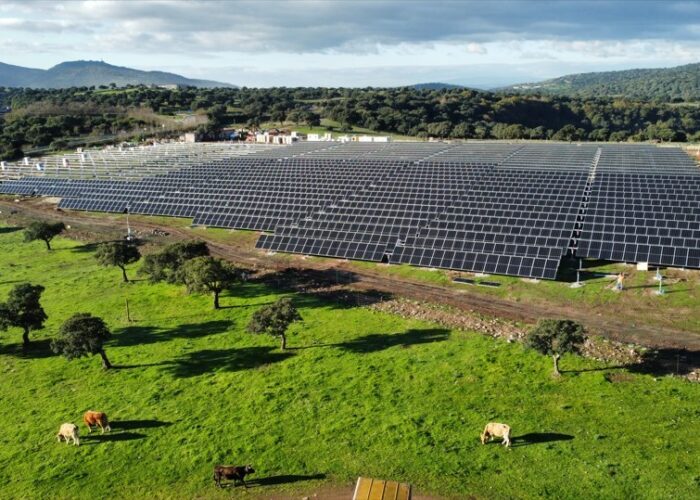
Research firm JMK Research has published its latest report into the Indian solar sector, which found that India installed 6.5GW of new utility-scale PV in 2023, alongside 3GW of new rooftop capacity, pushing India’s total installed solar capacity above 60GW for the first time.
According to ‘Annual India Solar Report Card CY2023’, while the utility-scale installation figures are lower than that of the record-breaking 2022, where 11.8GW of new capacity was installed, India’s total utility-scale capacity has now more than tripled from 2017, when utility-scale installations accounted for 17.6GW of capacity.
Unlock unlimited access for 12 whole months of distinctive global analysis
Photovoltaics International is now included.
- Regular insight and analysis of the industry’s biggest developments
- In-depth interviews with the industry’s leading figures
- Unlimited digital access to the PV Tech Power journal catalogue
- Unlimited digital access to the Photovoltaics International journal catalogue
- Access to more than 1,000 technical papers
- Discounts on Solar Media’s portfolio of events, in-person and virtual
By state, Rajasthan is India’s leader, with 17.4GW of cumulative utility-scale installs as of the end of 2023. The northern state was also one of three with a pipeline of new installations with a greater capacity than 2023 installations. According to JMK, Rajasthan’s utility-scale pipeline currently consists of 23.1GW of capacity, with Gujarat and Andhra Pradesh, the next two states in terms of 2023 capacity additions, also boasting a larger pipeline than what was installed last year.
This year has already seen a number of encouraging developments for new Indian projects. In March, SJVN Green Energy signed offtake agreements for 600MW of solar capacity in Rajasthan, and Tata Power commissioned the country’s largest solar-plus-storage project in Chhattisgarh.
Last year also proved a record year for rooftop capacity installations, as shown by the graph below. This growth has been encouraged by government support for new rooftop projects, and is expected to continue into the future. Earlier this year, as part of its interim budget, the government unveiled a plan to provide ten million citizens with free solar electricity.
Manufacturing driving exporting
Much of this growth has been driven by considerable expansions in the Indian manufacturing sector. Last week, 5B told PV Tech Premium that India’s “substantial industrial and policy programmes” has made the country an attractive destination for solar manufacturers.
While the top three companies in terms of module shipments are all Chinese – Jinko Solar, LONGi and Trina Solar accounted for 23.1%, 15.5% and 8.5% of India’s module shipments in 2023 – JMK figures demonstrate that, of the top ten companies in terms of total module shipments in 2023, six are based in India. Domestic companies are led by Waaree, which accounted for 7% of Indian module shipments.
A separate JMK report, published in collaboration with the Institute for Energy Economics and Financial Analysis (IEEFA), ‘India’s Photovoltaic Manufacturing Capacity Set to Surge’, goes into greater detail on the manufacturing sector. According to this report, between March 2022 and March 2023, India’s module manufacturing nameplate capacity more than doubled, from 18GW to 36GW, and the country has a manufacturing pipeline of around 110GW.
Should this pipeline be brought online, the report notes that India will be self-sufficient in terms of meeting its demand for solar modules by the 2026 financial year.
As is the case with the rooftop sector, much of this growth stems from positive government involvement, with the report’s authors arguing that the US$3.2 billion Production-Linked Incentive (PLI) scheme is “one of the primary catalysts spurring the growth of the entire PV manufacturing ecosystem in India”.
Strong domestic manufacturing has also increased the value of Indian solar exports, at a time where key markets, such as the US, are eager to reduce their imports from China, which has dominated the manufacture of solar products for years. The JMK and IEEFA report notes that, between 2022 and 2023, the value of Indian PV exports increased by more than five times, and JMK figures demonstrate how some of India’s largest PV manufacturers are committing a majority of their stock to exports.
According to JMK, Waaree, Adani and Vikram solar, the three Indian companies that produced the largest volume of modules for export in 2023, all exported more than 60% of their total production capacity. Waaree in particular, which exported more than 3GW of module capacity, exported 63.3% of this capacity, close to 2GW.
Looking ahead
JMK expects 2024 to be a record-breaking year for the Indian solar sector, expecting 15.9GW of new utility-scale capacity additions, alongside 4.2GW of new rooftop capacity additions, both of which would be records for their sub-sectors.
However, it is worth noting that the group’s predictions have been overly optimistic in the past. In the 2022 edition of its annual report card, JMK expected India to install 14GW of new utility-scale solar in 2023, following on from the record 11.4GW of new capacity added in 2022, more than double the capacity that was actually installed last year.
Similarly, in its 2020 report card, JMK estimated that India would add 9.7GW of new utility-scale capacity in 2021, which proved to be around triple the capacity actually installed, which sat at 3.7GW.
Yet there are reasons to remain optimistic, particularly in the manufacturing sector. The JMK and IEEFA report notes that the PLI scheme will “directly lead” to the establishment of 27.4GW of new polysilicon-to-module manufacturing capacity in India over the next few years, and will be essential to meeting its forecast of adding 110GW of module manufacturing capacity by 2026. The government has already taken steps to further support the solar industry, such as establishing new efficiency standards for cadmium telluride (CdTe) thin-film modules.







